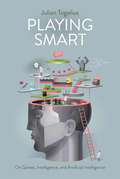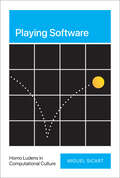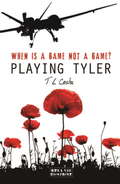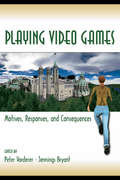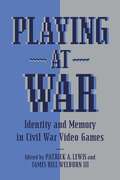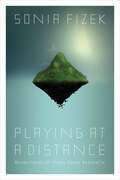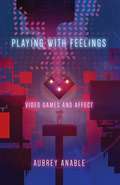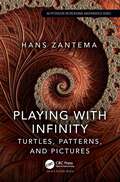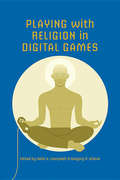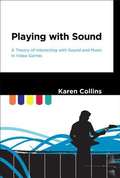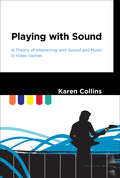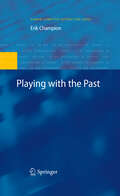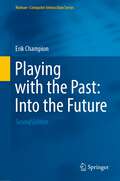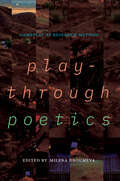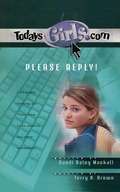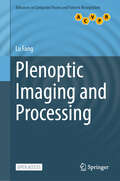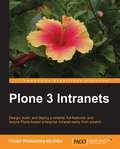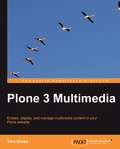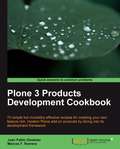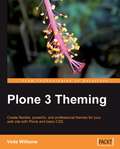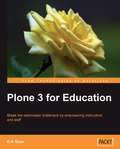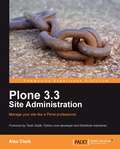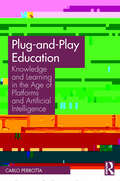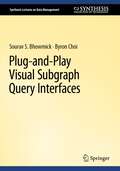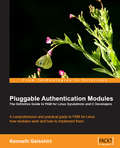- Table View
- List View
Playing Smart: On Games, Intelligence, and Artificial Intelligence (Playful Thinking)
by Julian TogeliusA new vision of the future of games and game design, enabled by AI. Can games measure intelligence? How will artificial intelligence inform games of the future? In Playing Smart, Julian Togelius explores the connections between games and intelligence to offer a new vision of future games and game design. Video games already depend on AI. We use games to test AI algorithms, challenge our thinking, and better understand both natural and artificial intelligence. In the future, Togelius argues, game designers will be able to create smarter games that make us smarter in turn, applying advanced AI to help design games. In this book, he tells us how. Games are the past, present, and future of artificial intelligence. In 1948, Alan Turing, one of the founding fathers of computer science and artificial intelligence, handwrote a program for chess. Today we have IBM's Deep Blue and DeepMind's AlphaGo, and huge efforts go into developing AI that can play such arcade games as Pac-Man. Programmers continue to use games to test and develop AI, creating new benchmarks for AI while also challenging human assumptions and cognitive abilities. Game design is at heart a cognitive science, Togelius reminds us—when we play or design a game, we plan, think spatially, make predictions, move, and assess ourselves and our performance. By studying how we play and design games, Togelius writes, we can better understand how humans and machines think. AI can do more for game design than providing a skillful opponent. We can harness it to build game-playing and game-designing AI agents, enabling a new generation of AI-augmented games. With AI, we can explore new frontiers in learning and play.
Playing Software: Homo Ludens in Computational Culture
by Miguel SicartThe play element at the heart of our interactions with computers—and how it drives the best and the worst manifestations of the information age.Whether we interact with video games or spreadsheets or social media, playing with software shapes every facet of our lives. In Playing Software, Miguel Sicart delves into why we play with computers, how that play shapes culture and society, and the threat posed by malefactors using play to weaponize everything from conspiracy theories to extractive capitalism. Starting from the controversial idea that software is an essential agent in the information age, Sicart considers our culture in general—and our way of thinking about and creating digital technology in particular—as a consequence of interacting with software&’s agency through play.As Sicart shows, playing shapes software agency. In turn, software shapes our agency as we adapt and relate to it through play. That play drives the creation of new cultural, social, and political forms. Sicart also reveals the role of make-believe in driving our playful engagement with the digital sphere. From there, he discusses the cybernetic theory of digital play and what we can learn from combining it with the idea that playfulness can mean pleasurable interaction with human and nonhuman agents inside the boundaries of a computational system. Finally, he critiques the instrumentalization of play as a tool wielded by platform capitalism.
Playing Tyler
by T L CostaWhen is a game not a game?Tyler MacCandless can't focus, even when he takes his medication. He can't focus on school, on his future, on a book, on much of anything other than taking care of his older brother, Brandon, who's in rehab for heroin abuse... again.Tyler's dad is dead and his mom has mentally checked out. The only person he can really count on is his Civilian Air Patrol Mentor, Rick. The one thing in life it seems he doesn't suck at is playing video games and, well, thats probably not going to get him into college.Just when it seems like his future is on a collision course with a life sentence at McDonald's, Rick asks him to test a video game. If his score's high enough, it could earn him a place in flight school and win him the future he was certain that he could never have. And when he falls in love with the game's designer, the legendary gamer Ani, Tyler thinks his life might finally be turning around.That is, until Brandon goes MIA from rehab and Tyler and Ani discover that the game is more than it seems. Now Tyler will have to figure out what's really going on in time to save his brother... and prevent his own future from going down in flames.
Playing Video Games: Motives, Responses, and Consequences (Routledge Communication Series)
by Peter Vorderer Jennings BryantFrom security training simulations to war games to role-playing games, to sports games to gambling, playing video games has become a social phenomena, and the increasing number of players that cross gender, culture, and age is on a dramatic upward trajectory. Playing Video Games: Motives, Responses, and Consequences integrates communication, psychology, and technology to examine the psychological and mediated aspects of playing video games. It is the first volume to delve deeply into these aspects of computer game play. It fits squarely into the media psychology arm of entertainment studies, the next big wave in media studies. The book targets one of the most popular and pervasive media in modern times, and it will serve to define the area of study and provide a theoretical spine for future research.This unique and timely volume will appeal to scholars, researchers, and graduate students in media studies and mass communication, psychology, and marketing.
Playing at War: Identity and Memory in Civil War Video Games (American Wars and Popular Culture)
by Matthew E. Stanley Nick Sacco Matthew Christopher Hulbert Christian McWhirter Daniel Farrell Dr James Frusetta Dr Blake Hill Dr Jonathan S. Jones John R. Legg Dr Holly Pinheiro Jacopo Della Quercia Dr David Silkenat Dr Kathleen Logothetis Thompson Dr Charles R. Welsko Dr Katherine L. Brackett Dr Stephen Edwards Aaron M. Phillips Dr Erzsebet FazekasPlaying at War offers an innovative focus on Civil War video games as significant sites of memory creation, distortion, and evolution in popular culture. With fifteen essays by historians, the collection analyzes the emergence and popularity of video games that topically engage the period surrounding the American Civil War, from the earliest console games developed in the 1980s through the web-based games of the twenty-first century, including popular titles such as Red Dead Redemption 2 and War of Rights. Alongside discussions of technological capabilities and advances, as well as their impact on gameplay and content, the essays consider how these games engage with historical scholarship on the Civil War era, the degree to which video games reflect and contribute to popular understandings of the period, and how those dynamics reveal shifting conceptions of martial identity and historical memory within U.S. popular culture. Video games offer productive sites for extending the analysis of Civil War memory into the post–Confederates in the Attic era, including the political and cultural moments of Obama and Trump, where overt expressions of Lost Cause memory were challenged and removed from schools and public spaces, then embraced by new manifestations of white supremacist organizations. Edited by Patrick A. Lewis and James Hill Welborn III, Playing at War traces the drift of Civil War memory into digital spaces and gaming cultures, encouraging historians to engage more extensively with video games as important cultural media for examining how contemporary Americans interact with the nation’s past.
Playing at a Distance: Borderlands of Video Game Aesthetic
by Sonia FizekAn essential exploration of video game aesthetic that decenters the human player and challenges what it means to play.Do we play video games or do video games play us? Is nonhuman play a mere paradox or the future of gaming? And what do video games have to do with quantum theory? In Playing at a Distance, Sonia Fizek engages with these and many more daunting questions, forging new ways to think and talk about games and play that decenter the human player and explore a variety of play formats and practices that require surprisingly little human action. Idling in clicker games, wandering in walking simulators, automating gameplay with bots, or simply watching games rather than playing them—Fizek shows how these seemingly marginal cases are central to understanding how we play in the digital age. Introducing the concept of distance, Fizek reorients our view of computer-mediated play. To &“play at a distance,&” she says, is to delegate the immediate action to the machine and to become participants in an algorithmic spectacle. Distance as a media aesthetic framework enables the reader to come to terms with the ambiguity and aesthetic diversity of play. Drawing on concepts from philosophy, media theory, and posthumanism, as well as cultural and film studies, Playing at a Distance invites a wider understanding of what digital games and gaming are in all their diverse experiences and forms. In challenging the common perception of video games as inherently interactive, the book contributes to our understanding of the computer&’s influence on practices of play—and prods us to think more broadly about what it means to play.
Playing with Feelings: Video Games and Affect
by Aubrey AnableHow gaming intersects with systems like history, bodies, and code Why do we so compulsively play video games? Might it have something to do with how gaming affects our emotions? In Playing with Feelings, scholar Aubrey Anable applies affect theory to game studies, arguing that video games let us &“rehearse&” feelings, states, and emotions that give new tones and textures to our everyday lives and interactions with digital devices. Rather than thinking about video games as an escape from reality, Anable demonstrates how video games—their narratives, aesthetics, and histories—have been intimately tied to our emotional landscape since the emergence of digital computers.Looking at a wide variety of video games—including mobile games, indie games, art games, and games that have been traditionally neglected by academia—Anable expands our understanding of the ways in which these games and game studies can participate in feminist and queer interventions in digital media culture. She gives a new account of the touchscreen and intimacy with our mobile devices, asking what it means to touch and be touched by a game. She also examines how games played casually throughout the day create meaningful interludes that give us new ways of relating to work in our lives. And Anable reflects on how games allow us to feel differently about what it means to fail.Playing with Feelings offers provocative arguments for why video games should be seen as the most significant art form of the twenty-first century and gives the humanities passionate, incisive, and daring arguments for why games matter.
Playing with Infinity: Turtles, Patterns, and Pictures (AK Peters/CRC Recreational Mathematics Series)
by Hans ZantemaThis is a book about infinity - specifically the infinity of numbers and sequences. Amazing properties arise, for instance, some kinds of infinity are argued to be greater than others. Along the way the author will demonstrate how infinity can be made to create beautiful ‘art’, guided by the development of underlying mathematics. This book will provide a fascinating read for anyone interested in number theory, infinity, math art, and/or generative art, and could be used a valuable supplement to any course on these topics.Features: Beautiful examples of generative art Accessible to anyone with a reasonable high school level of mathematics Full of challenges and puzzles to engage readers
Playing with Religion in Digital Games
by Heidi A. Campbell Gregory P. GrieveShaman, paragon, God-mode: modern video games are heavily coded with religious undertones. From the Shinto-inspired Japanese video game Okami to the internationally popular The Legend of Zelda and Halo, many video games rely on religious themes and symbols to drive the narrative and frame the storyline. Playing with Religion in Digital Games explores the increasingly complex relationship between gaming and global religious practices. For example, how does religion help organize the communities in MMORPGs such as World of Warcraft? What role has censorship played in localizing games like Actraiser in the western world? How do evangelical Christians react to violence, gore, and sexuality in some of the most popular games such as Mass Effect or Grand Theft Auto? With contributions by scholars and gamers from all over the world, this collection offers a unique perspective to the intersections of religion and the virtual world.
Playing with Sound: A Theory of Interacting with Sound and Music in Video Games
by Karen CollinsKaren Collins examines video game sound from the player's perspective. She explores the many ways that players interact with a game's sonic aspects -- which include not only music but also sound effects, ambient sound, dialogue, and interface sounds -- both within and outside of the game. She investigates the ways that meaning is found, embodied, created, evoked, hacked, remixed, negotiated, and renegotiated by players in the space of interactive sound in games. Drawing on disciplines that range from film studies and philosophy to psychology and computer science, Collins develops a theory of interactive sound experience that distinguishes between interacting with sound and simply listening without interacting. Her conceptual approach combines practice theory (which focuses on productive and consumptive practices around media) and embodied cognition (which holds that our understanding of the world is shaped by our physical interaction with it). Collins investigates the multimodal experience of sound, image, and touch in games; the role of interactive sound in creating an emotional experience through immersion and identification with the game character; the ways in which sound acts as a mediator for a variety of performative activities; and embodied interactions with sound beyond the game, including machinima, chip-tunes, circuit bending, and other practices that use elements from games in sonic performances.
Playing with Sound: A Theory of Interacting with Sound and Music in Video Games
by Karen CollinsAn examination of the player's experience of sound in video games and the many ways that players interact with the sonic elements in games. In Playing with Sound, Karen Collins examines video game sound from the player's perspective. She explores the many ways that players interact with a game's sonic aspects—which include not only music but also sound effects, ambient sound, dialogue, and interface sounds—both within and outside of the game. She investigates the ways that meaning is found, embodied, created, evoked, hacked, remixed, negotiated, and renegotiated by players in the space of interactive sound in games.Drawing on disciplines that range from film studies and philosophy to psychology and computer science, Collins develops a theory of interactive sound experience that distinguishes between interacting with sound and simply listening without interacting. Her conceptual approach combines practice theory (which focuses on productive and consumptive practices around media) and embodied cognition (which holds that our understanding of the world is shaped by our physical interaction with it).Collins investigates the multimodal experience of sound, image, and touch in games; the role of interactive sound in creating an emotional experience through immersion and identification with the game character; the ways in which sound acts as a mediator for a variety of performative activities; and embodied interactions with sound beyond the game, including machinima, chip-tunes, circuit bending, and other practices that use elements from games in sonic performances.
Playing with the Past
by Erik ChampionHow can we increase awareness and understanding of other cultures using interactive digital visualizations of past civilizations? In order to answer the above question, this book first examines the needs and requirements of virtual travelers and virtual tourists. Is there a market for virtual travel? Erik Champion examines the overall success of current virtual environments, especially the phenomenon of computer gaming. Why are computer games and simulations so much more successful than other types of virtual environments? Arguments that virtual environments are impeded by technological constraints or by a paucity of evaluation studies can only be partially correct, for computer games and simulations are also virtual environments. Many of the underlying issues are caused by a lack of engagement with the philosophical underpinnings of culture, presence and inhabitation, and there are few exemplars that engage the public with history and heritage using interactive media in a meaningful and relevant manner. The intention of Playing With the Past is to help designers and critics understand the issues involved in creating virtual environments that promote and disseminate historical learning and cultural heritage through a close study of the interactive design principles at work behind both real and virtual places. Topics discussed include the design of virtual environments, and especially virtual heritage environments, virtual place-making, cultural presence, the pros and cons of game-style interaction, augmented reality projects, and appropriate evaluation methods. Virtual heritage environments discussed in the book include projects from Antarctica, Australia, Mexico, Malta, Egypt, Babylon, the Netherlands, Cambodia, and India.
Playing with the Past: Into the Future (Human–Computer Interaction Series)
by Erik ChampionSince the turn of this century (and even earlier), a plethora of projects have arisen to promise us bold new interactive adventures and immersive travel into the past with digital environments (using mixed, virtual or augmented reality, as well as computer games). In Playing with the Past: Into the Future Erik Champion surveys past attempts to communicate history and heritage through virtual environments and suggests new technology and creative ideas for more engaging and educational games and virtual learning environments.This second edition builds on and updates the first edition with new game discussions, surveys, design frameworks, and theories on how cultural heritage could be experienced in digital worlds, via museums, mobile phones, or the Metaverse. Recent games and learning environments are reviewed, with provocative discussion of new and emerging promises and challenges.
Playthrough Poetics: Gameplay as Research Method
by Milena DroumevaGame streamers and live commentators are producing increasingly comprehensive analyses of gameplay, yet scholarship still tends to flatten the experiential media of video games into text for close reading. By shifting focus toward the immersiveness of video games, Playthrough Poetics makes the case for gameplay as a necessary, alternate method. Contributors to this volume engage widely with the activity of play through autoethnographies, meta-analyses of self-broadcasting, new procedural methods like gamespace soundwalking, as well as the affective aspects of games research. In doing so, they model new possibilities for academic players and gamers alike. Rigorous scholarship meets cultural practice in this innovative, multi-modal edited collection that includes video essays and offers transcripts of the playthroughs themselves. Readers (and viewers) will come away with a toolkit of models, case studies, and conceptual frameworks for analyzing video games through gameplay. This volume is a fresh return to the joy of play: the poetics of games as contemporary forms of storytelling and interactivity. With contributions from Ashlee Bird, Brandon Blackburn, Milena Droumeva, Kishonna Gray, Robyn Hope, Ben Scholl, Maria Sommers, Ashlyn Sparrow, Christine Tran, and Aaron Trammell.
Please Reply!
by Dandi Daley MackallAs fifteen-year-old Jamie becomes involved in the swim team and Special Olympics coaching, as part of her effort to fit in and be normal, she tries to remember to talk to God.
Plenoptic Imaging and Processing (Advances in Computer Vision and Pattern Recognition)
by Lu FangThis open access book delves into the fundamental principles and cutting-edge techniques of plenoptic imaging and processing. Derived from the Latin words "plenus" (meaning "full") and "optic," plenoptic imaging offers a transformative approach to optical imaging. Unlike conventional systems that rely solely on the pinhole camera model to capture spatial information, plenoptic imaging aims to detect and reconstruct multidimensional and multiscale information from light rays in space. Chapter 1 begins with the introduction of the basic principle of the plenoptic function and the historical development of plenoptic imaging. Next, Chapter 2 describes representative plenoptic sensing systems, including single-sensor devices with lenslet arrays, coded-aperture masks, structured camera arrays, and unstructured camera arrays. Then, Chapter 3 introduces gigapixel plenoptic sensing techniques capable of capturing large-scale dynamic scenes with extremely high resolution. Further, chapter 4 examines typical plenoptic reconstruction methods, including light-field image reconstruction, image-based, and RGBD-based geometry reconstruction. After that, chapter 5 tackles the challenges of large-scale plenoptic reconstruction by introducing sparse-view priors, high-resolution observations, and semantic information. Finally, chapter 6 discusses the frontier issues of plenoptic processing, including the gigapixel-level video dataset PANDA and corresponding visual intelligent algorithms.
Plone 3 Intranets
by Victor Fernandez AlbaThis is a step-by-step guide, from installing your first Plone instance to deploying your intranet. Each chapter will show you an essential aspect that your intranet should have. However, each chapter is isolated enough to serve as a reference manual for later use. The book is packed with examples and useful screenshots for easy learning. This book is for anyone who needs to build an intranet with no limits on capabilities or features. Even if you don't have previous CMS experience or programming skills, this book is for you. Targeted at beginners with no previous experience with Plone, this book will teach you step by step and at the end you should have a full-featured, reliable, and secure intranet.
Plone 3 Multimedia
by Tom GrossThis book is written in a tutorial style where you work through examples that describe how you can create multimedia applications using Plone and integrate your existing multimedia resources into your website. It also tells you how to use multimedia effectively giving many ideas and best practices. This book is for Plone integrators who want to extend the core of Plone with multimedia features. It gives no introduction to Plone and readers should know how to set up a Plone site using a buildout. The book can be read and understood well without being a Python developer, though some examples have Python code included.
Plone 3 Products Development Cookbook
by Juan Pablo GimenezThe examples in this book follow a sample project creating a digital newspaper website to meet the requirements of a fictional customer who wants to place commercial advertisements all over the site. The whole book is a comprehensive collection of recipes that elaborate a series of well known use cases. You will find an organized step-by-step procedure to accomplish each task followed by detailed explanations to better understand how and why each topic was undertaken, and many links to online references and other related sections in the book that can supplement the subject in question. You can read the whole book or just pick the recipes that are relevant for you; where necessary, cross references will help you understand the recipes even if you do not read them in sequential order. This book is for programmers who have some knowledge of Python, Plone, and Zope. If you want to develop feature-rich add-on products in Plone, this book is for you. It is aimed at the development of backend features, so you need not have other web-related skills such as HTML, CSS, or JavaScript.
Plone 3 Theming
by Veda WilliamsThis book provides a holistic look at theming Plone sites as well as step-by-step instructions on how to create Plone themes. The book first briefly introduces the concepts and necessary tools and then moves on to describing the concepts needed for customizing templates in Plone. It also provides handy tips and tricks along the way to simplify the theming process. This book is targeted at professional web designers working with Plone who want to create their own unique look and feel for a Plone web site.
Plone 3 for Education
by Erik RoseThis book is written especially for time-constrained web teams. Every chapter is hands-on from start to finish, focusing on getting a value-adding site up fast. Necessary theory and tips on best practices are interspersed with the step-by-step instructions, broken out into sidebars so it informs your progress without impeding it. Also, every chapter is independent, dealing with a specific use case--for example, publishing video, creating forms, or representing assignment schedules and syllabi--so you can skip straight to what you need. Most chapters require no programming at all. The few where we dig deeper (for example, to build our own plug-in products) are replete with working code samples and explanations of what's going on. A rudimentary knowledge of the Python programming language is helpful in these but is not essential. Plone 3 for Education is for the makers of school web sites, from primary to university, from e-learning to public-facing, from tech-savvy teachers to seasoned software developers. A user-level familiarity with Plone is the only prerequisite; everything else is baked in.
Plone 3.3 Site Administration
by Alex ClarkThis book is a step-by-step tutorial guide, explaining many common and fundamentally important Plone site administration tasks. This book is designed for site administrators, webmasters, or content editors managing a site with Plone. These users will not be new to Plone itself, but they will be new to the site administration tasks. The reader is also expected to know basic Python programming. This book caters to these users, and builds their confidence by helping them to get their Plone sites up, running, and customized with minimal peripheral knowledge.
Plug-and-Play Education: Knowledge and Learning in the Age of Platforms and Artificial Intelligence
by Carlo PerrottaPlug-and-Play Education: Knowledge and Learning in the Age of Platforms and Artificial Intelligence documents and critiques how the education sector is changing with the advancement of ubiquitous edtech platforms and automation. As programmability and computation reengineer institutions towards efficiency and prediction, the perpetual collection of and access to digital data is creating complex opportunities and concerns. Drawing from research into secondary and higher education settings, this book examines the influence of digital “infrastructuring”, the automation of teaching and learning, and the very purpose of education in a context of growing platformisation and artificial intelligence integration. These theoretical, practical, and policy-oriented insights will offer educational technologists, designers, researchers, and policymakers a more inclusive, diverse, and open-ended perspective on the design and implementation of learning technologies.
Plug-and-Play Visual Subgraph Query Interfaces (Synthesis Lectures on Data Management)
by Sourav S. Bhowmick Byron ChoiThis book details recent developments in the emerging area of plug-and-play (PnP) visual subgraph query interfaces (VQI). These PnP interfaces are grounded in the principles of human-computer interaction (HCI) and cognitive psychology to address long-standing limitations to bottom-up search capabilities in graph databases using traditional graph query languages, which often require domain experts and specialist programmers. This book explains how PnP interfaces go against the traditional mantra of VQI construction by taking a data-driven approach and giving end users the freedom to easily and quickly construct and maintain a VQI for any data sources without resorting to coding. The book walks readers through the intuitive PnP interface that uses templates where the underlying graph repository represents the socket and user-specified requirements represent the plug. Hence, a PnP interface enables an end user to change the socket (i.e., graph repository) or the plug (i.e., requirements) as necessary to automatically and effortlessly generate VQIs. The book argues that such a data-driven paradigm creates several benefits, including superior support for visual subgraph query construction, significant reduction in the manual cost of constructing and maintaining a VQI for any graph data source, and portability of the interface across diverse sources and querying applications. This book provides a comprehensive introduction to the notion of PnP interfaces, compares it to its classical manual counterpart, and reviews techniques for automatic construction and maintenance of these new interfaces. In synthesizing current research on plug-and-play visual subgraph query interface management, this book gives readers a snapshot of the state of the art in this topic as well as future research directions.
Pluggable Authentication Modules: The Definitive Guide to PAM for Linux SysAdmins and C Developers
by Kenneth GeisshirtThis book provides a practical approach to UNIX/Linux authentication. The design principles are explained thoroughly, then illustrated through the examination of popular modules. It is intended as a one-stop introduction and reference to PAM. This book is for experienced system administrators and developers working with multiple Linux/UNIX servers or with both UNIX and Windows servers. It assumes a good level of admin knowledge, and that developers are competent in C development on UNIX-based systems.
